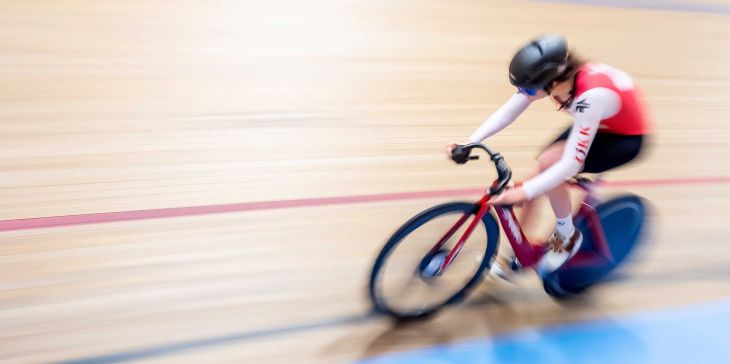The municipality of Grenchen in the Swiss canton of Solothurn is home to the Tissot Velodrome, which boasts a 250-metre-long racetrack made from Siberian spruce. The steeply banked, 7-metre-wide track is housed in an arena that normally seats up to 3,500 spectators. Today, the venue is empty, though the electronic music that has flooded the space since early morning means it’s far from quiet. Flurina Rigling is absorbed in the solitary task of completing one lap after another on her red track bike. It’s a special day for the 26-year-old Swiss para-athlete, who has a disability in both of her hands and feet: she’s trying out new handlebars for the very first time.
Standing next to the track, his gaze fixed on the two lap-time displays, is Luca Hasler, an ETH mechanical engineering student who developed the handlebars as part of his Master’s thesis. For the past six months, he has been entirely engrossed in the development of this black aluminium bar and the two plastic hand-rests that are moulded to the shape of Rigling’s hands. He has spent countless hours with Rigling, puzzling over the best design, and now the moment of truth has arrived. Have the new handlebars really made her any faster? And do they feel safe and comfortable under race conditions?
But first: how did Rigling even get to this stage in her career? Her rise in the world of para-cycling has been nothing short of meteoric. She only took up cycling seriously three years ago, but her titles already include vice-world champion in the time-trial event and European road-race champion. She also took gold in the world track championships in a record-beating time.
Rigling, a Zurich native who is currently enrolled at a training camp for elite athletes, achieved all this with handlebars that were far from perfect. Not only did she have to balance her hand on a 3-centimetre-wide cantilever; she also had to operate the brake and gearshift with her only finger.
With so much pressure concentrated on one spot, the old handlebars made for an uncomfortable ride. In addition, they forced her into an awkward posture with poor aerodynamics – sometimes enough to make the difference between victory and defeat. “I realised some time ago that I needed new handlebars,” says Rigling. But she had no idea who might be able to help.
An unusual Master's thesis
Help eventually arrived in the form of Peter Wolf from the Sensory-Motor Systems Lab at ETH Zurich. He advertised the project as a Master’s thesis and, in spring 2022, 26-year-old Luca Hasler accepted the challenge. “It was the perfect combination for me because I’m interested in applied product development, and I ride a racing bike,” he says. He was given six months to develop the new handlebars.
But where to start? “I tried to put myself in Flurina’s shoes and to learn as much as I could about the difficulties she was facing,” says Hasler. This was the “empathising” part of the design-thinking approach that Hasler favours. In June 2022, he went to see Rigling at the Swiss Championships in Steinmauer, near Zurich. This was his first opportunity to see how she held the handlebars, and he quickly understood what had to be done: “It’s really difficult for Flurina to hold the handlebars with one finger, so she clearly needed custom hand-rests that would enable her to ride her bike safely, comfortably and aerodynamically.”
Getting in shape
Based on this information, the conventional approach would have been to design, produce and test the handlebars on a computer. That wasn’t an option in this case, however, because Hasler still had no idea what the hand-rests should look like. He needed to develop a method of defining, testing and optimising the hand-rest design as quickly, simply and cheaply as possible.
The breakthrough came when he visited the rehabilitation clinic in Bellikon. There, he met Rigling’s orthopaedic technician, who suggested using a thermoplastic, which can be moulded into different shapes once it reaches a certain temperature. This proved to be the perfect solution to roughly model the structure of Rigling’s hands.
Replicating the delicate contours of her hands, however, proved a tougher challenge that required a more flexible material. Once again, the ETH student drew inspiration from orthopaedic technology, opting for a fast-curing silicone moulding putty, which is also used for finger prostheses. Equipped with these two materials and numerous other tools, Hasler headed to the racing cyclist’s family home one hot day last summer.














